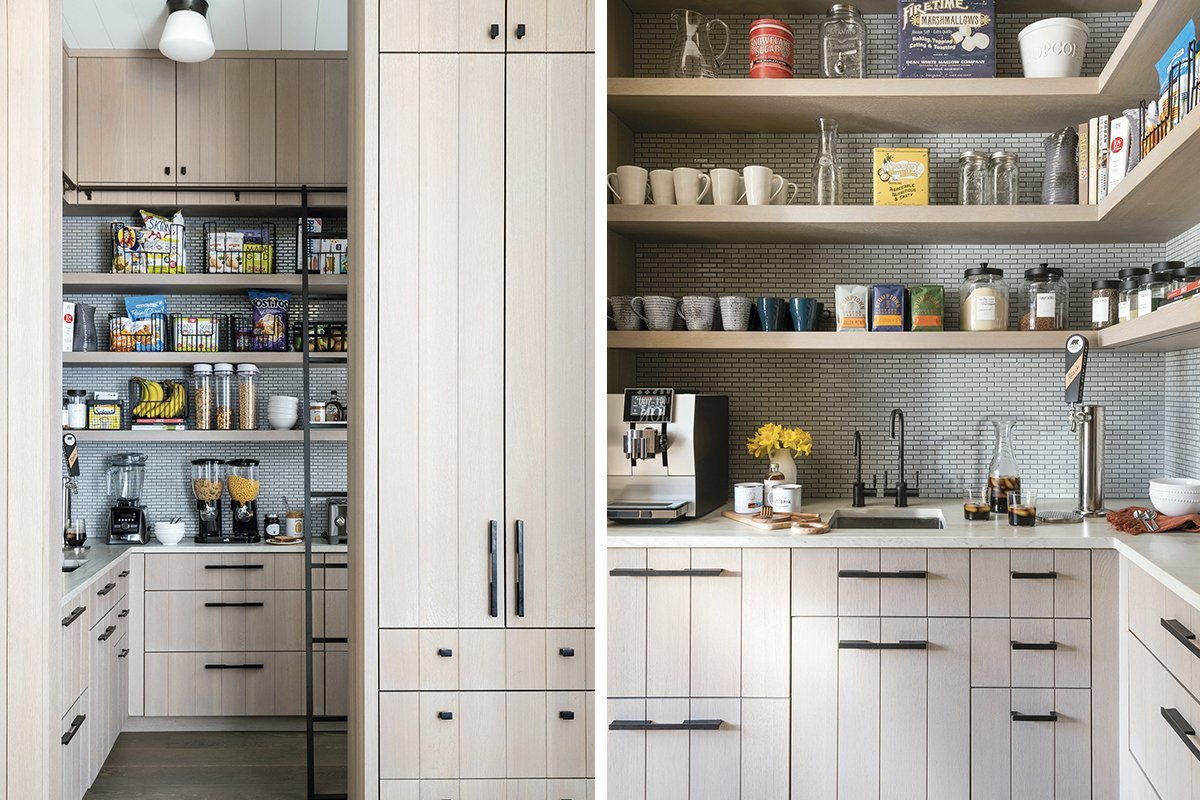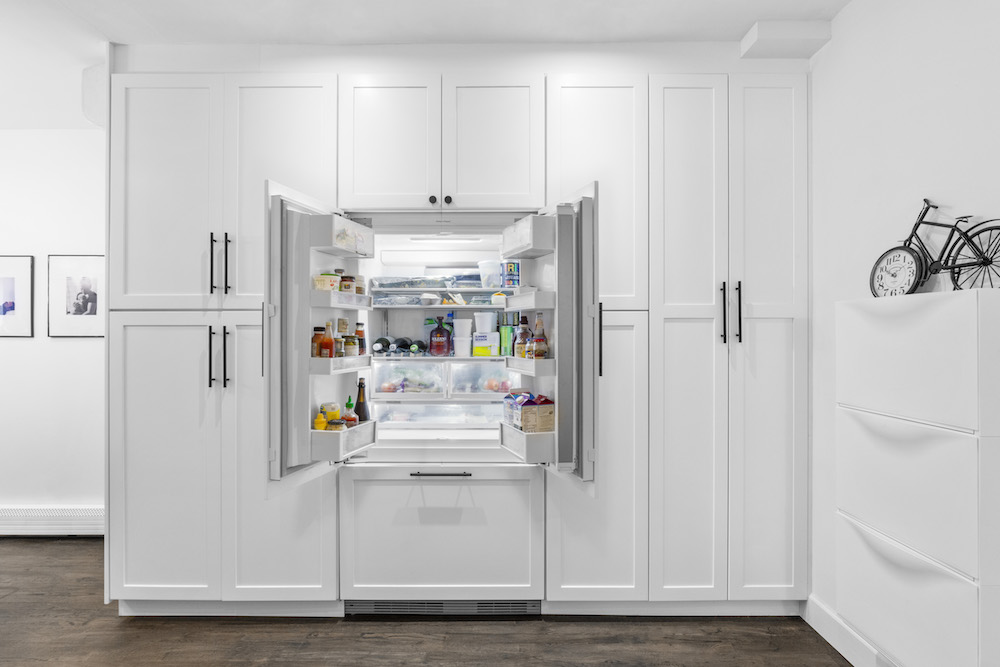Layout and Design Considerations

A pantry cabinet positioned next to your refrigerator creates a culinary haven, streamlining your workflow and maximizing storage. This strategic placement minimizes wasted steps and creates a seamless transition between food storage and preparation.
Optimizing Space Between Pantry Cabinet and Fridge
This space can be a design challenge, but with careful planning, it can become a functional and aesthetically pleasing area. The key is to create a harmonious balance between accessibility and visual appeal.
Pantry Cabinet Layout Options
Here are some layout options for pantry cabinets next to fridges, considering dimensions and features:
| Layout | Dimensions (inches) | Features |
|---|---|---|
| Single-Door Cabinet | 18″ wide x 24″ deep x 72″ high | Ideal for smaller spaces. Offers ample storage for dry goods and canned items. |
| Double-Door Cabinet | 36″ wide x 24″ deep x 72″ high | Provides greater storage capacity, perfect for larger kitchens. Offers more room for organizing various food items. |
| Corner Cabinet | 36″ wide x 36″ deep x 72″ high | Maximizes corner space, perfect for maximizing storage in tight kitchens. Often features pull-out shelves and drawers for easy access. |
Design for Efficient Storage
A well-designed pantry cabinet should be a symphony of functionality and aesthetics. Consider these elements for optimal storage:
“Shelves, drawers, and pull-out baskets offer a versatile storage solution, accommodating various food items.”
* Shelves: Adjustable shelves are essential for accommodating different sized containers and maximizing vertical space.
* Drawers: Deep drawers are ideal for storing heavier items, such as canned goods or baking supplies.
* Pull-out baskets: These provide easy access to frequently used items and keep them organized.
Ideal Spacing for Access and Aesthetics
Maintaining the perfect distance between the pantry cabinet and refrigerator is crucial for functionality and aesthetics.
“A minimum of 18 inches of space between the cabinet and the fridge allows for comfortable access and prevents crowding.”
This spacing ensures that you can easily open both the pantry door and the refrigerator door without obstruction. It also creates a visually appealing flow between the two appliances, contributing to a harmonious kitchen design.
Storage Solutions and Organization

Transforming your pantry cabinet into a haven of culinary delights requires a strategic approach to organization. By implementing smart storage solutions, you can create a space that is both functional and visually appealing.
Designating Sections for Food Categories
Dividing your pantry cabinet into dedicated sections for different food categories ensures that you can quickly locate the items you need. For example, a designated area for grains, another for canned goods, and a separate section for snacks can streamline your grocery shopping and meal preparation.
Advantages of Pull-Out Shelves and Drawers
Pull-out shelves and drawers offer a number of advantages for pantry organization. They provide easy access to items stored in the back of the cabinet, eliminating the need to rummage through stacks of containers. Additionally, they create a more organized and visually appealing space, allowing you to see everything at a glance.
Pantry Organization Tools
A range of pantry organization tools can help you maximize space and create a more efficient system.
Dividers:
These tools are essential for separating different food categories within shelves, creating distinct sections for grains, canned goods, and snacks.
Bins:
Bins provide a convenient way to store similar items together, such as pasta, rice, or baking supplies. They can be labeled for easy identification.
Labels:
Labels are essential for identifying the contents of bins and containers, ensuring that you can quickly locate what you need.
Storing Bulky Items, Pantry cabinet next to fridge
Storing bulky items like pots, pans, and baking sheets in a pantry cabinet can be challenging. However, with a little creativity, you can maximize space and create a functional storage solution.
Vertical Storage:
Utilize vertical space by hanging pots and pans from hooks or racks mounted on the inside of the cabinet door.
Stacking:
Stacking baking sheets and other flat items can be a space-saving solution, but ensure that they are properly secured to prevent them from sliding.
Tiered Storage:
Consider using tiered shelves or risers to create multiple levels of storage within the cabinet, allowing you to maximize space for bulky items.
Functional Benefits and Considerations: Pantry Cabinet Next To Fridge

A pantry cabinet positioned next to the refrigerator seamlessly integrates storage and meal preparation, transforming the kitchen into a haven of culinary efficiency. This strategic placement optimizes workflow, minimizing steps and maximizing convenience.
Streamlined Workflow and Easy Access
The proximity of the pantry cabinet to the refrigerator facilitates a smooth and efficient workflow, eliminating unnecessary steps and wasted time. Imagine the convenience of effortlessly grabbing spices, condiments, or pantry staples while preparing meals. This strategic arrangement streamlines the culinary process, allowing you to focus on the joy of cooking.
Preventing Spills and Messes
Maintaining a clean and organized pantry cabinet area is crucial to prevent spills and messes. To ensure a clutter-free environment, consider implementing these tips:
- Utilize spill-proof containers for liquids and powders to minimize the risk of accidental spills.
- Implement a designated cleaning routine for the pantry cabinet, wiping down shelves and surfaces regularly to prevent the accumulation of crumbs and debris.
- Store heavy items on lower shelves to reduce the chance of them falling and creating a mess.
Challenges of Placing a Pantry Cabinet Next to the Fridge
While the placement of a pantry cabinet next to the refrigerator offers numerous advantages, it’s essential to acknowledge potential challenges:
- The proximity of the refrigerator can lead to increased heat and humidity within the pantry cabinet, potentially impacting the shelf life of stored items.
- The size and configuration of the kitchen may limit the available space for a pantry cabinet, requiring careful planning and measurement to ensure a suitable fit.
Ventilation and Moisture Control
Proper ventilation is crucial to prevent moisture buildup and maintain a healthy environment within the pantry cabinet. Consider these measures:
- Ensure adequate air circulation by leaving a small gap between the pantry cabinet and the refrigerator.
- Install a vent or fan to remove excess moisture and prevent mold growth.
- Store items in airtight containers to protect them from moisture and maintain freshness.
Pantry cabinet next to fridge – You know, that space next to the fridge is often wasted. It’s the perfect spot for a pantry cabinet, but who wants a bulky one? That’s where the magic of a 3 inch wide cabinet comes in. It’s narrow enough to fit in that tight spot, yet surprisingly spacious for storing spices, oils, or even snacks.
So, you can have a pantry cabinet next to your fridge without sacrificing precious floor space.
You know, I’ve always found that the placement of a pantry cabinet next to the fridge is a classic kitchen layout for a reason. It creates a sense of flow and efficiency, making grabbing snacks or ingredients a breeze. But when it comes to storage solutions, the same principles apply to other spaces too, like bathrooms.
Take a look at these bathroom sink cabinet designs – they’re all about maximizing space and functionality. Just like a well-designed pantry cabinet next to the fridge, a smart bathroom sink cabinet can transform a cluttered space into a haven of organization.
